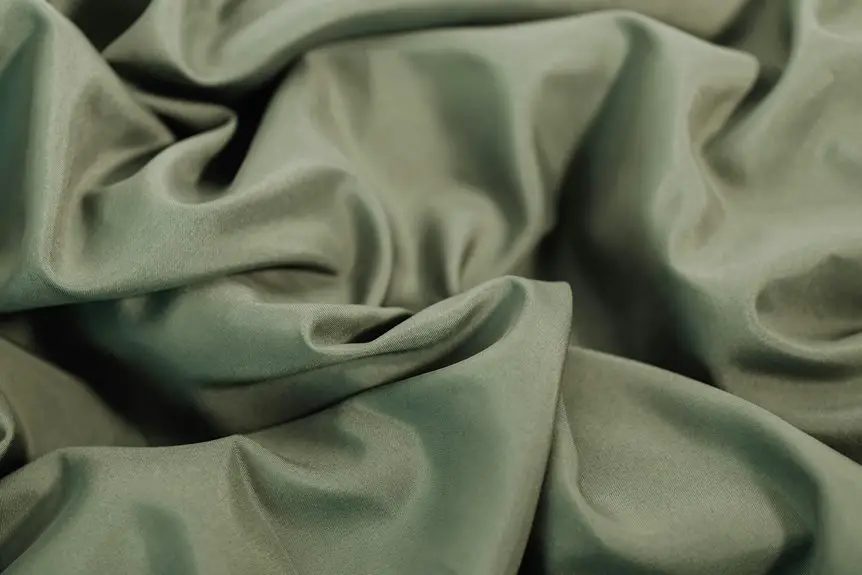Understanding fabric weight helps you pick the right crepe for your project by balancing drape, durability, and comfort. Lightweight crepe flows softly, perfect for airy blouses, while medium weight offers versatility for dresses and pants. Heavyweight crepe adds structure and warmth for outerwear. You’ll want to take into account fabric weight alongside fiber content and sewing needs for best results. Keep exploring to discover how to match crepe weight with your desired garment style and season.
Table of Contents
Key Takeaways
- Fabric weight determines drape, durability, and comfort, crucial for selecting crepe suitable for your garment’s style and season.
- Lightweight crepe (low GSM) offers softness and flow, ideal for airy blouses and delicate designs.
- Medium-weight crepe balances durability and shape retention, perfect for dresses, skirts, and versatile garments.
- Heavyweight crepe provides structure and insulation, best for tailored outerwear and formal pieces.
- Measure fabric weight accurately using GSM or ounces per square yard to match fabric properties with project needs.
What Is Fabric Weight and Why Does It Matter?
Fabric weight refers to how heavy a fabric feels, and it directly affects how your crepe garment drapes, moves, and wears.
When you choose a lighter crepe, it tends to flow softly, making it ideal for blouses or dresses that need elegant movement. Heavier crepe fabrics hold shape better and offer more structure, perfect for tailored jackets or pants.
Understanding fabric weight helps you predict the garment’s comfort and suitability for different seasons. If the fabric’s too heavy, it might feel restrictive and hot; too light, and it might lack durability or appear sheer.
Common Methods for Measuring Fabric Weight
Knowing how heavy or light your crepe fabric is can make all the difference when selecting the right material for your project.
To measure fabric weight, you’ll commonly rely on a few straightforward methods. One popular way is using a precision scale to weigh a small, standardized swatch of fabric. This gives you a clear idea of the fabric’s density.
Another method involves referring to manufacturer specifications, where fabric weight is often listed per unit area. Sometimes, you might also estimate weight based on fabric thickness and hand feel, especially if you’re experienced.
These approaches help you gauge how your crepe will drape, hold shape, or feel against the skin, ensuring you pick the perfect fabric for your sewing needs.
The Difference Between GSM and Ounces per Square Yard
You might’ve seen fabric weight listed as GSM or ounces per square yard, but they measure the same thing differently.
GSM stands for grams per square meter and is commonly used worldwide, while ounces per square yard is more typical in the US.
Understanding both helps you compare fabric weights accurately when choosing your crepe.
GSM Explained
Although both GSM and ounces per square yard measure fabric weight, they use different systems and can sometimes confuse buyers.
GSM stands for grams per square meter, a metric measurement that tells you how many grams one square meter of fabric weighs. It’s widely used worldwide, especially in countries that follow the metric system. Understanding GSM helps you easily compare fabric weights regardless of size.
Here’s what you need to know about GSM:
- GSM measures fabric density by weight over a fixed area (1 square meter).
- Higher GSM means a heavier, thicker fabric; lower GSM indicates lighter fabric.
- It’s a straightforward metric, making it easy to gauge fabric quality.
- GSM is standard in textile manufacturing, ensuring consistency across products.
Using GSM, you can select the perfect crepe weight for your project confidently.
Ounces per Yard
While GSM measures fabric weight in grams per square meter, ounces per square yard offers an alternative system commonly used in the United States. This method tells you how many ounces a one-yard square of fabric weighs.
When choosing crepe, knowing the ounces per yard helps you understand its heaviness and drape. For instance, lighter crepes might weigh around 3 to 5 ounces per yard, perfect for flowy garments, while heavier crepes can be 6 ounces or more, offering more structure.
If you’re used to GSM, remember that 1 ounce per square yard roughly equals 33.9 GSM. By comparing these units, you can confidently pick the right crepe weight, no matter which measurement you encounter.
Characteristics of Lightweight Crepe Fabrics
Since lightweight crepe fabrics offer exceptional breathability and fluidity, they’re perfect for creating garments that move gracefully and feel comfortable all day.
When you choose lightweight crepe, you’ll notice several key characteristics that make it stand out:
- Soft drape: It flows smoothly, enhancing movement without stiffness.
- Sheer texture: Often slightly translucent, adding delicate elegance.
- Cool feel: Breathes well, making it ideal for warm weather clothing.
- Delicate structure: Requires gentle handling and careful sewing due to its fine weave.
These features make lightweight crepe a top choice when you want airy, elegant pieces that are light on your skin and easy to style for various occasions.
Medium Weight Crepe: Versatility and Popular Uses
You’ll find medium weight crepe perfect for a variety of garments like dresses, skirts, and jackets because it drapes beautifully while staying durable.
Its balanced weight gives you both structure and flow, making it a versatile choice for many styles.
Once you try it, you’ll see why it’s so popular among designers and wearers alike.
Ideal Garment Types
If you want a fabric that adapts well to different styles, medium weight crepe offers the perfect balance. It’s sturdy enough to hold shape yet flexible enough for movement, making it ideal for various garments.
You’ll find it works great for:
- Dresses – Especially those with structured silhouettes or slight drapes.
- Blouses – Providing a polished look with comfortable wear.
- Pants – Offering a tailored fit without stiffness.
- Skirts – Perfect for both flowy and A-line styles.
Choosing medium weight crepe means your project gains versatility, fitting both casual and formal wardrobes.
This fabric supports designs that need a bit of body without sacrificing softness, so you can confidently create pieces that look sharp and feel good to wear.
Draping and Durability
Medium weight crepe strikes a balance that makes it both adaptable and reliable for your projects.
When you work with this fabric, you’ll notice its graceful drape, which softly contours to shapes without being too stiff or too loose. This quality lets you create garments that flow elegantly yet hold their form, perfect for dresses, skirts, and tailored pieces.
Beyond its look, medium weight crepe stands up well to regular wear and washing, offering durability without sacrificing comfort. You won’t have to worry about it sagging or tearing easily, making it ideal for everyday wear or special occasions.
Choosing this crepe means you get a fabric that moves beautifully and lasts, giving your creations both style and substance.
Heavyweight Crepe: Structure and Durability
Anyone seeking a crepe that stands up to frequent wear will find heavyweight crepe an excellent choice.
This fabric boasts a dense weave and substantial weight, giving it superior structure and durability.
When you pick heavyweight crepe, you benefit from:
- Enhanced resistance to wrinkles and creases, keeping garments looking sharp longer.
- Increased longevity, making it ideal for items worn regularly or exposed to rough conditions.
- A firm texture that holds shape well, perfect for tailored pieces or structured designs.
- Better insulation, offering warmth without bulky layering.
How Fabric Weight Affects Draping and Flow
While heavyweight crepe offers structure and durability, lighter fabrics bring a different set of qualities to your garments.
When you choose a lighter crepe, you’ll notice how effortlessly it drapes and moves with your body. This fabric weight allows for fluidity, creating graceful silhouettes and soft folds. You can achieve elegant flow in dresses, blouses, or scarves, where movement and softness matter most.
Conversely, heavier crepes will hold shape but limit flexibility and natural flow. By understanding how fabric weight influences draping, you can better control your garment’s final look and feel.
Lighter crepes invite a breezier, more delicate aesthetic, while heavier ones provide firmness and structure—key to matching your design intentions without sacrificing comfort or style.
Choosing Crepe Weight Based on Garment Type
You’ll want to pick your crepe weight based on the garment you’re making.
Light crepe works best for airy blouses, while medium crepe suits dresses perfectly.
For outerwear, go with heavy crepe to guarantee durability and structure.
Light Crepe for Blouses
Light crepe fabric offers the perfect balance of softness and drape, making it ideal for blouses that require both comfort and style.
When you choose light crepe for your blouse, you get a breathable fabric that moves gracefully with your body. This weight is especially suitable for warmer weather or layered looks.
Here’s why you should consider light crepe for your blouse:
- It provides excellent airflow, keeping you cool all day.
- The fabric’s natural texture adds subtle elegance without stiffness.
- Light crepe drapes beautifully, enhancing feminine silhouettes.
- It’s easy to sew and maintain, perfect for both beginners and pros.
Opting for light crepe guarantees your blouse looks polished and feels comfortable.
Medium Crepe for Dresses
If you enjoyed how light crepe moves and breathes in blouses, medium crepe offers a bit more structure that works perfectly for dresses.
This weight strikes a balance between flow and form, providing enough body to shape your garment without sacrificing comfort. Medium crepe drapes nicely, giving dresses a polished look while allowing ease of movement.
It holds pleats and gathers well, making it ideal for styles requiring subtle volume or definition. When choosing medium crepe, consider the dress design and occasion; it suits both casual and semi-formal wear.
Plus, it’s durable enough for frequent use without feeling heavy. So, if you want a fabric that supports your dress’s silhouette while keeping it wearable, medium crepe is a smart choice.
Heavy Crepe for Outerwear
A heavy crepe provides the perfect foundation for outerwear, offering the structure and durability needed to withstand the elements. When you choose heavy crepe for coats, jackets, or blazers, you get fabric that holds shape well and resists wear.
Here’s why heavy crepe works best for outerwear:
- Insulation – It traps warmth, keeping you cozy in cooler weather.
- Durability – It resists abrasion and maintains appearance over time.
- Weight & Drape – It provides a substantial feel without sacrificing fluidity.
- Wind Resistance – The dense weave blocks wind better than lighter fabrics.
When you pick heavy crepe, your outerwear will look sharp and perform well, making it a smart choice for functional, stylish garments.
Seasonal Considerations When Selecting Crepe Weight
When temperatures drop, you’ll want to choose a heavier crepe to provide extra warmth and durability. Heavier crepes block cold winds better, making them ideal for fall and winter garments like coats and skirts.
In contrast, as temperatures rise, lighter crepes are your go-to. They offer breathability and comfort without adding bulk, perfect for spring and summer dresses or blouses.
Keep in mind the climate you live in and the season when you plan to wear your project. If you’re working on a shifting piece, medium-weight crepe strikes a balance, offering enough warmth without overheating.
Combining Fabric Weight With Fiber Content for Best Results
Selecting the right crepe weight helps you match seasonal needs, but combining that choice with fiber content takes your garment’s performance to the next level.
Choosing crepe weight and fiber content together elevates your garment’s seasonal performance and comfort.
Different fibers interact uniquely with fabric weight, affecting drape, durability, and comfort. Here’s how to pair them effectively:
- Silk Crepe: Best with lightweight fabric for flow and elegance.
- Wool Crepe: Works well with medium to heavy weights, offering warmth and structure.
- Polyester Crepe: Versatile across weights; adds wrinkle resistance and ease of care.
- Cotton Crepe: Ideal in lighter weights for breathability and softness.
Tips for Sewing Different Weights of Crepe
Though crepe fabrics vary widely in weight and texture, you can achieve professional results by adjusting your sewing techniques accordingly.
For lightweight crepes, use sharp needles and fine thread to prevent snagging, and consider French seams to keep edges neat and durable.
Medium-weight crepes handle standard sewing equipment well, but always test on a scrap first to adjust tension and stitch length.
Heavyweight crepes need stronger needles and possibly a longer stitch length to avoid puckering.
Press seams carefully with a low-heat iron and a pressing cloth to protect the fabric’s texture.
Regardless of weight, use pins sparingly to avoid marks and sew slowly to maintain control.
These adjustments help you work confidently with any crepe, ensuring your project looks polished and lasts long.
Where to Buy Quality Crepe Fabrics by Weight
Finding quality crepe fabrics by weight can make all the difference in your sewing projects. Knowing where to buy guarantees you get the exact fabric that matches your design and durability needs.
Here are four reliable sources to take into account:
- Specialty Fabric Stores – They often carry a wide range of crepe weights and allow you to feel the fabric before buying.
- Online Fabric Retailers – Websites like Fabric.com and Mood Fabrics provide detailed descriptions and customer reviews.
- Local Textile Markets – Great for hands-on shopping and discovering unique crepe options.
- Wholesale Suppliers – Ideal if you need larger quantities and want to save by buying by weight.
Frequently Asked Questions
Can Fabric Weight Affect the Color Vibrancy of Crepe?
Did you know 70% of fabric dye intensity depends on fiber density? Yes, fabric weight affects crepe’s color vibrancy—heavier crepes absorb more dye, giving you richer colors, while lighter ones appear softer and more muted.
How Does Fabric Weight Influence Fabric Care and Washing?
Fabric weight affects washing because heavier fabrics can handle vigorous washing, while lighter ones need gentle care. You’ll want to adjust water temperature and cycle type to prevent damage and maintain your fabric’s look and feel.
Is Fabric Weight Related to the Environmental Impact of Crepe Production?
Yes, fabric weight can affect the environmental impact since heavier crepe often requires more raw materials and energy to produce. You’ll want to contemplate this when choosing, balancing durability with sustainability to reduce your project’s footprint.
Can Fabric Weight Determine the Cost of Crepe Fabric?
Yes, fabric weight often influences crepe fabric’s cost. Heavier crepes use more material, making them pricier. So, when you choose fabric weight, you’re also deciding on your project’s budget.
Does Fabric Weight Affect the Breathability of Crepe Materials?
You might think heavier crepe is always less breathable, but that’s not true. Fabric weight does affect breathability—lighter crepes let air pass through easier, while heavier ones tend to trap heat more, so choose accordingly.
- Poly-Cotton vs. Rayon: A Detailed Fabric Comparison - June 23, 2025
- How to Get Stains Out of Your Cotton Polyester Clothes - June 23, 2025
- The History of Poly-Cotton: A Fabric That Changed an Industry - June 23, 2025






